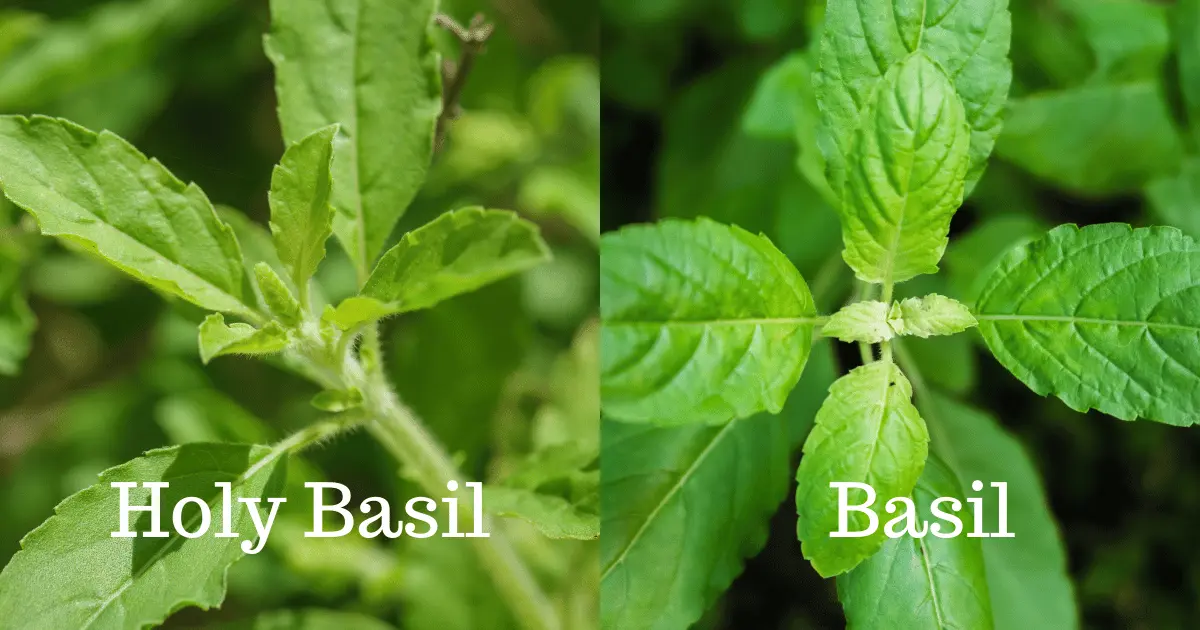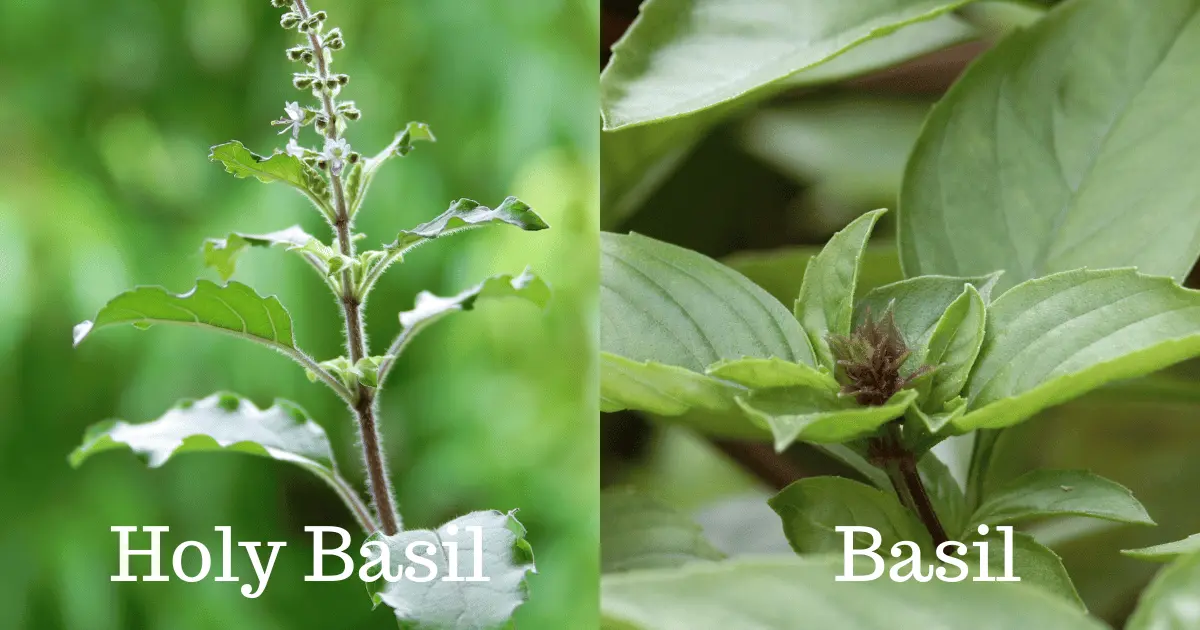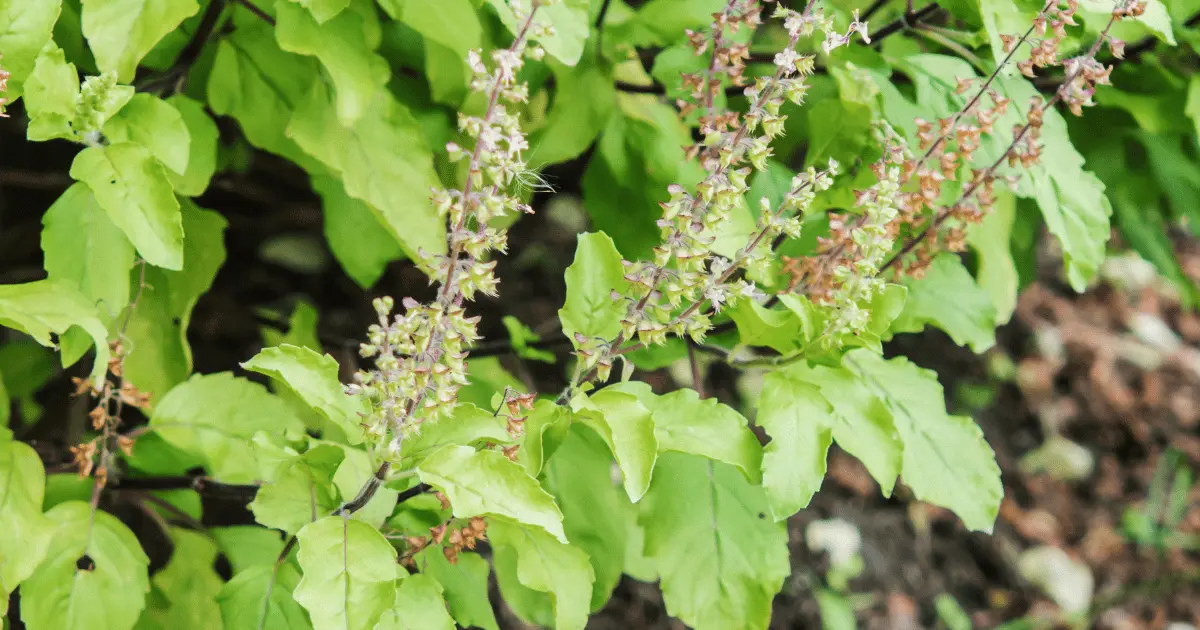Holy basil and basil are two popular varieties of basil. They are both members of the Lamiaceae family and are species within the Ocimum genus. Despite the similarities, both herbs have unique histories and uses.
Holy Basil vs. Basil

Holy basil (Ocimum sanctum), known as Tulsi, is an aromatic herb plant with many health benefits, including aiding digestion, improving the respiratory system, and boosting immunity. In India, holy basil is called tulsi or hot basil because it is often used in Ayurvedic medicine to treat illness. It is also called Tulasi or Vrinda, after the Hindu goddesses, and can often be found adorning Hindu shrines.
Basil (Ocimum basilicum) is an aromatic culinary herb used as a flavoring agent in several cuisines. Its leaves have some good health and medicinal benefits, including asthma and diabetes mellitus and reducing stress, among others. Basil is native to India but has been grown and enjoyed around the globe for centuries.
Basil is the most commonly grown of all basil varieties. The plant grows erect, reaching heights of up to two feet, with plump, spear-shaped leaves with smooth margins.
History
Both herbs are native to Southeast Asia. However, holy basil is an important herb in Southeast Asian history and culture. It gained its name from the cultural belief in India that it has special spiritual powers and can impart great medicinal benefits to those who eat it.
Meanwhile, basil is thought to have also originated in Southeast Asia but has long been found in other parts of the world, including ancient Egypt and ancient Greece. For years, basil has been grown throughout the Mediterranean. Today, it is a commonly-grown herb popular worldwide and a staple ingredient in Mediterranean countries, Asia, and the United States.
Appearance

When it comes to appearance, holy basil has a hairy stem, unlike regular basil with a smooth stem. Holy basil is surrounded by white and very thin hair, a few millimeters long. The edges differentiate their leaves.
Holy basil has tooth-like edges, and basil leaves have smooth edges. Holy basil leaves are flatter, whereas regular basil leaves tend to bend downwards. Holy basil flowers are white or pink/purple, while regular basil is white. The shape of each flower is given by small petals arranged in tubular shapes.
Taste
Holy basil is said to have a taste described as peppery with a background of clove. Although there are many reports concerning its taste but depends on the different varieties of holy basil within this species.
Uses
The major use of basil is for culinary purposes. Asides from the health and medicinal benefits, basil leaves are used to add to the taste and flavor of any delicacy.
Unlike holy basil leaves, Basil leaves are used to add flavor to delicacies and are always added at the last step of cooking. Delicacies like simple kinds of pasta to pesto-based condiments are considered the main flavors added to delicacies.
Holy basil is mostly used for its medicinal properties and religious purposes. Apart from these, Tulsi and its extracts are used in several home remedies, herbal tea, etc. However, its strong antibacterial properties are good for healing skin infections, improving digestion, etc.
Basil is also more of a staple in Mediterranean dishes because it has a sweeter, anise-like flavor that adds a distinctive aroma and taste to various dishes from Italy and Greece. It is the main ingredient in pesto, a sauce often used in pizza or pasta. Basil is also used in Mediterranean salads, such as Caprese salad, which includes mozzarella and tomatoes.
Cultivation

Holy basil is from the mint family (Lamiaceae), often called “the queen of herbs.” It can be two different herbs; ocimum gratissimum or ocimum tenuiflorum. Holy basil is an annual plant in most parts of the United States.
Holy basil can be grown in the garden or container, but be sure to use a good container because the plant grows up to two feet tall. The plant needs partial to full sunlight, and Holy basil needs well-draining soil to grow well. If you decide on starting the seeds indoors, start planting six weeks before the last predicted frost date.
Provide the necessary water and heat for the seed to grow, which can be transplanted into the garden when matured. When planting the seeds, maintain proper spacing, which can be two feet apart if placed in rows.
It is so because of the size of the plant, and the plant can receive lots of air. It’s advisable to use the deep watering method to allow the plant to grow with enough water and won’t stay soggy.
All types of basil grow well in warm, sunny weather. It’s a perennial or annual herb that grows up to 18-24 inches tall and wide. Regular basil is ready for harvest in 60-90 days from seeding
Growing Requirements
Light
Giving holy basil plenty of sunlight will ensure large healthy leaves. The plant will tolerate some shade but not anything lower.
With 6 to 8 hours of exposure to sunlight, basil grows best. In hotter climates, basil prefers part shade.
Soil
The best soil type is light and airy but also rich at the same time. Loamy soil is a good choice because it retains moisture but drains properly.
Basil grows well in rich, moist, and well-draining soil. You should amend your soil with compost.
Water
Keep the soil moist and not soggy. Holy basil will grow healthy and abundant. Basil needs consistent watering, good soil, and good light.
Temperature
An average of 70°F is necessary for the plant to grow well and wither. Basil plant loves heat. If you live in a frost-free area, you should allow the basil plants to self-seed in your garden.
Fertilizer
The use of fertilizer to grow holy basil is not recommended. Fertilize your basil plants of
Common pest/disease
Aphids are known to be the biggest pest tormenting the basil plant, especially when the plant grows indoors. However, beetles and slugs can harm this plant indoors,y creating holes in the leaves.
Powdery mildew also affects the plant but can be controlled by providing lots of space between plants to improve air circulation further.
Fusarium wilt affects the plants by giving them stunted growth, yellowing leaves, and much more leaf issues. Others include; Downy mildew, root rot, and slugs, among others.
